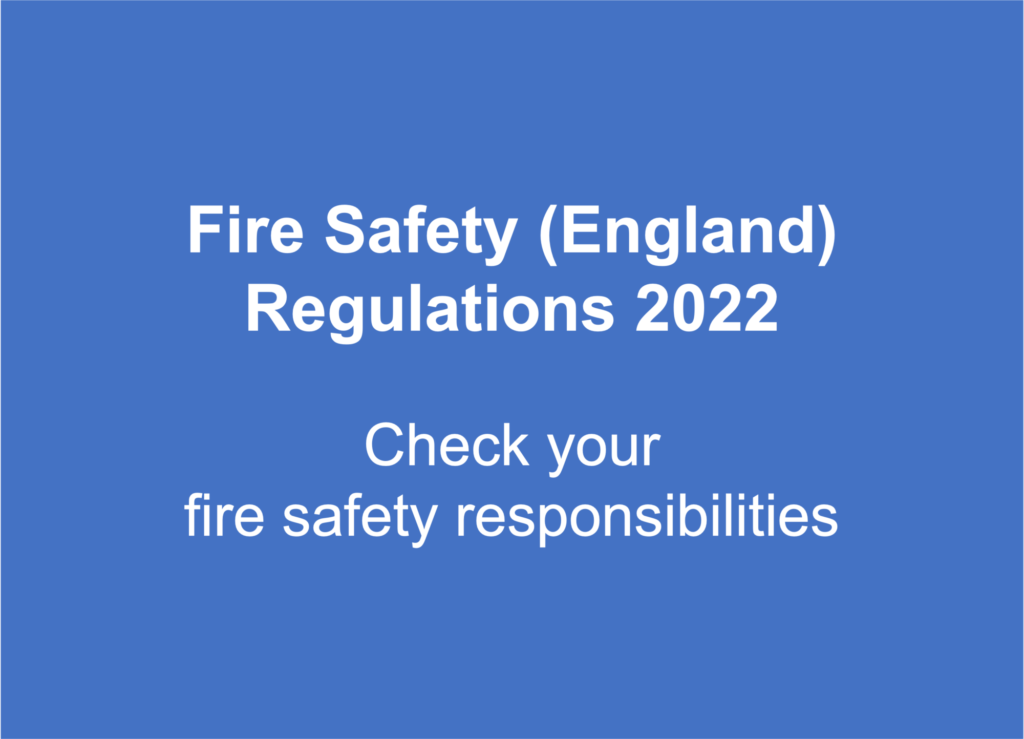An Overview of Recent Fire Safety Legislation
- Published: 9th Oct 23
- Category: News
Over the last 18 months we have seen a flurry of fire safety regulation so the intention of this article is to summarise the new duties placed on landlords.
The Legislation
The Fire Safety Act 2021 has introduced significant changes in the wake of the Grenfell Tower tragedy. The Act and subsequent regulations, has been brought in in three phases with the last phase coming into force on 1st October 2023.
It amends the Regulatory Reform (Fire Safety) Order 2005 (RRFSO) and expands its scope to include all buildings with two or more domestic premises, not just those with communal areas. This amendment significantly increases the number of buildings that are now required to be managed in line with the new laws.
Responsible Person
Article 3 of the RRFSO 2005 defines the responsible person (RP) as being the person in control of the premises and invariably this will mean the freeholder or building manager. And of course there are plenty of single houses that have been converted into two or three flats with separate owners all sharing a percentage of the freehold. Between them they must appoint a responsible person.
The RP is the person who will undertake or organise a Fire Risk Assessment. They will also be required to implement requirements under each phase. In larger buildings, these duties are wider.
Buildings with two or more domestic premises
Where as previously a Fire Risk Assessment was only required where there were communal areas, now all buildings that fall into this category will need one carried out. The Risk Assessment must cover the whole building encompassing the structure, doors, windows, balconies, internal and external flues, cladding and so on.
Buildings with two or more domestic premises with common areas
Alongside the risk assessment there is a requirement to provide information to residents. These are:
- instructions relating to the evacuation strategy for the building,
- instructions as regards how to report a fire to the fire and rescue authority, and
- any other instruction that tells residents what they must do when a fire has occurred
- that fire doors should be kept shut when not in use
- that residents or their guests should not tamper with the self-closing devices
- that residents should report any faults or damages with doors immediately to the responsible person
This information should be displayed in the common areas and given to the residents. Individual landlords should ensure that any tenant has received this, and for new tenants (and any permitted occupiers) as soon as is reasonably practical after they move in.
Under the regulations this information must be provided to existing residents by the 23rd January 2024 and then again, once every 12 months.
Buildings over 11 metres in height
In addition to the provision of information, RP’s of buildings that exceed 11 meters should have fire door checks done on a regular basis.
Communal doors should be checked every three months whilst individual flat entrance doors should be checked every 12 months. The check can be basic and visual and includes ensuring there is no damage to the door or frame, no defects in hinges and smoke seals are in place. You can find guidance at the end of this article on how to check fire doors.
As long as the flat entrance door remains fire safe, there is no requirement to replace it to meet current building regulation standards.
Buildings over 18 metres in height
Once we get to buildings of this size, the Building Safety Act 2022 also applies. Whilst all of the previous information applies, as you might expect there are additional requirements to assist the Fire and Rescue Service in the event of a fire.
These include:
- Signage indicating floor numbers and flat numbers on each floor;
- Smoke control systems should be checked once a month;
- Fire fighting equipment and systems including rising mains should be checked once a month;
- Amny lifts should be checked on a monthly basis;
- A record of the design and materials of the external walls. This must be sent to the Fire Service;
- Floor plans and building plan. This must be sent to the Fire Service;
- A secure information box positioned so that the Fire Service can access it. Information should include a copy of the floor plans and building plan
Section 113 of the Building Safety Act creates a new Section 47A in the Landlord and Tenant Act 1987. This new section requires safety information to be provided along with any demand for rent. This would include any letters you send chasing rent arrears.
Further advice and information
If you are a landlord affected by this and are in need of further guidance, please do contact us.
You might also find the following links helpful:
People with duties under Fire Safety law
Guidance for small blocks of flats
Checking your fire safety responsibilities
Please note the date this article was published as the law or the essence may have changed since it was posted. You should always seek independent legal advice if you are intending to rely on any of the contents. Unless stated otherwise this article only reflects the position for the Private Rented Sector in England and therefore may not apply to other countries within the United Kingdom.
All resources & news